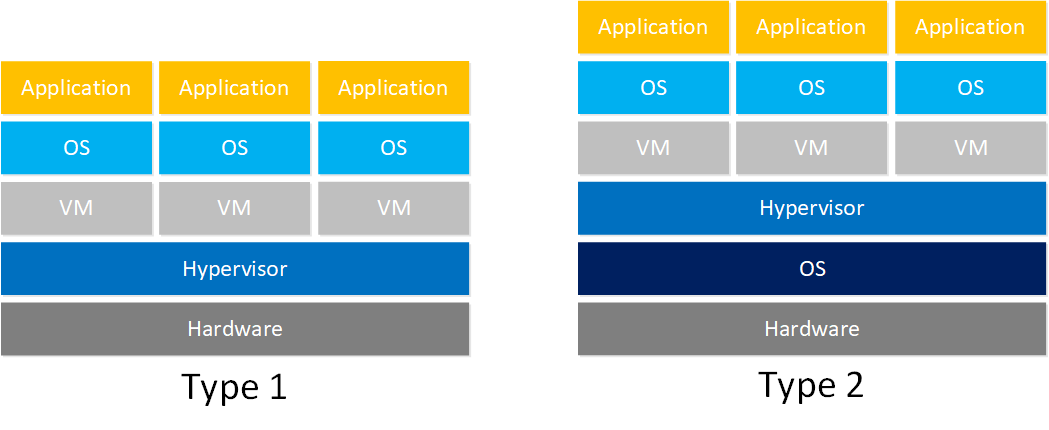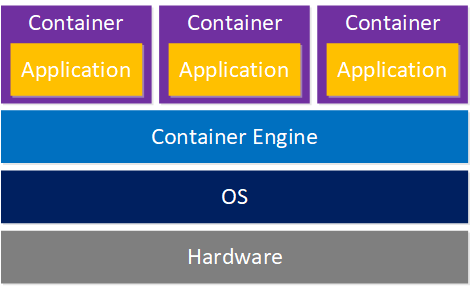Lesson Contents
In this lesson, we’ll take a look at the differences between virtual machines and containers.
Virtual Machines
Back in the days, a physical server would only run a single operating system with one or a few applications. We started with CPUs with a single core, then hyperthreading, and then multiple cores. The amount of memory in a single physical server also increased and became more affordable.

One of the reasons virtualization is now so popular is that servers were under-utilized. We can easily run multiple operating systems and multiple applications on a single physical server. A virtual machine is pretty identical to a physical server except it’s virtual. We have virtual hardware (CPUs, memory, storage, etc.) which runs on a hypervisor.
The hypervisor is the server virtualization software that runs on the physical server. This is where we create virtual machines and configure how much CPU cores, memory, storage, etc. each virtual machine has. There are two hypervisor types:
- Type 1: this hypervisor runs directly on hardware, which means you can assign more resources to virtual machines. Examples are VMware ESXi, Citrix Xen, KVM, and Microsoft Hyper-V.
- Type 2: this hypervisor runs on top of an operating system like Microsoft Windows, Apple MacOS, or Linux. We usually use a type 2 hypervisor on desktops or laptops. Two popular hypervisors are Oracle VM Virtualbox and VMWare Workstation. If you have never played with virtual machines before, give Virtualbox a try. You can download it for free.

When the hypervisor or the underlying physical server crashes, all your virtual machines disappear. Fortunately, there are products so you can migrate virtual machines from one physical server to another with no downtime or noticeable latency.
One advantage of virtual machines is that we are familiar with physical servers. It’s easy to understand, it’s a server, but virtual. We can use all the management and security tools we know to manage our physical or virtual servers.
One disadvantage of virtual machines is that there is a lot of overhead. For example, let’s say I want to run the freeradius application. A virtual machine with the Ubuntu 18.04 LTS operating system and nothing else installed is already ~3400 MB. Freeradius and its dependencies require about 5 MB. This brings my total storage to 3400 + 5 = 3405 MB.
That’s 3405 MB of storage only to run a simple application. Starting a virtual machine can take minutes, it has to boot the OS and start your applications
Containers
Containers are sometimes called light-weight virtual machines, but they are nothing like virtual machines.
A container is a “package” that only contains an application and its dependencies, nothing more. This package is stored as a container image. Containers run on top of a container engine, which runs on top of an operating system. Starting a container is very quick since the operating system is already running. Containers are isolated from each other by the container engine.

Containerization has many advantages:
- Small: the container image only has the application and its dependencies, nothing more. This results in a small container image. For example, I created a container image with freeradius. It’s only ~ 5 MB and has everything you need to run freeradius.
- Fast: you don’t have to start a virtual server with a virtual BIOS and virtual operating system. Spinning up a container is as fast as starting an application and only takes milliseconds.
- Portability: The container image has everything the application needs. I can create a container image on my local machine, then ship somewhere else like a remote server. If it runs on my computer, it will run on other computers or servers.
- Isolation: containers run on the same operating system but are isolated from each other. When one container crashes, it doesn’t affect the other containers.
- Scalability: You can add more identical containers when you need to scale out. Since containers are small and start quickly, you can scale out and in easily.
- Immutability: container images are built based on a “blueprint”. The freeradius image I mentioned earlier is a Docker container; the blueprint is called a Dockerfile. When you change your code, you build a new container image.
Are there any disadvantages to containers? Containers are isolated from each other on the process level which could be less secure than a virtual machine which is fully isolated.
Another issue is security. Containers are based on a blueprint which is basically like a snapshot. You build the container image from the blueprint, and the container doesn’t change anymore. If you want to update your container, you rebuild a new container image. This is different from a (virtual) server which you configure to install the latest security updates automatically.
Be careful that you run no container images that are outdated and might have vulnerabilities. For example, take a look at the Apache container images on Docker hub:



Hi Rene
If i undertand well I can replace the usage of VM by containers
If i have centos 7 installed can I have a container of Centos 7 with differents IP ?
Hello Fabrice,
It depends on the application but often it is possible to replace a VM with one or more containers. Be aware that you don’t treat containers as “mini VMs”. It’s possible to build a container with multiple applications but the idea behind containers is that each container only runs a single process.
There is a official CentOS container btw:
https://hub.docker.com/_/centos?tab=description
With a docker container it’s possible to add a static IP to each container.
Rene
Can explain what this statement says,
Immutability: container images are built based on a “blueprint”. The freeradius image I mentioned earlier is aDockercontainer; the blueprint is called aDockerfile. When you change your code, you build a new container image.Hello Gowtham
Welcome back! Immutability, in general, is a word that means “unchangeable” or “unmodifiable”. When we apply it in terms of Docker and other technological concepts (such as blockchain), we are referring to an immutable, unchangeable, read-only entity. If you want to modify it, you can’t. You must create a new one with the new parameters you want. Let’s dig deeper…
A Dockerfile is a blueprint (aka recipe) containing step-by-step instructions to build a container image. It specifies the base OS, packages to install, files to copy, configuration
... Continue reading in our forum